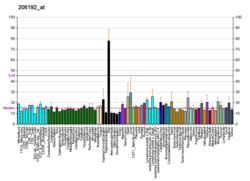Corneodesmosin
Protein-coding gene in the species Homo sapiens
| CDSN | |||||||||||||||||||||||||||||||||||||||||||||||||||
|---|---|---|---|---|---|---|---|---|---|---|---|---|---|---|---|---|---|---|---|---|---|---|---|---|---|---|---|---|---|---|---|---|---|---|---|---|---|---|---|---|---|---|---|---|---|---|---|---|---|---|---|
| Identifiers | |||||||||||||||||||||||||||||||||||||||||||||||||||
| Aliases | CDSN, D6S586E, HTSS, HTSS1, HYPT2, PSS, PSS1, corneodesmosin, S | ||||||||||||||||||||||||||||||||||||||||||||||||||
| External IDs | OMIM: 602593; MGI: 3505689; HomoloGene: 48005; GeneCards: CDSN; OMA:CDSN - orthologs | ||||||||||||||||||||||||||||||||||||||||||||||||||
| |||||||||||||||||||||||||||||||||||||||||||||||||||
| |||||||||||||||||||||||||||||||||||||||||||||||||||
| |||||||||||||||||||||||||||||||||||||||||||||||||||
| |||||||||||||||||||||||||||||||||||||||||||||||||||
| |||||||||||||||||||||||||||||||||||||||||||||||||||
| Wikidata | |||||||||||||||||||||||||||||||||||||||||||||||||||
| |||||||||||||||||||||||||||||||||||||||||||||||||||
Corneodesmosin is a protein that in humans is encoded by the CDSN gene.[5][6][7]
This gene encodes a protein found in corneodesmosomes, which localize to the human epidermis and other cornified squamous epithelia. During maturation of the cornified layers, the protein undergoes a series of cleavages, which are thought to be required for desquamation. The gene is located in the major histocompatibility complex (MHC) class I region on chromosome 6.[7]
See also
References
- ^ a b c GRCh38: Ensembl release 89: ENSG00000204539 – Ensembl, May 2017
- ^ a b c GRCm38: Ensembl release 89: ENSMUSG00000039518 – Ensembl, May 2017
- ^ "Human PubMed Reference:". National Center for Biotechnology Information, U.S. National Library of Medicine.
- ^ "Mouse PubMed Reference:". National Center for Biotechnology Information, U.S. National Library of Medicine.
- ^ Simon M, Montezin M, Guerrin M, Durieux JJ, Serre G (Jan 1998). "Characterization and purification of human corneodesmosin, an epidermal basic glycoprotein associated with corneocyte-specific modified desmosomes". J Biol Chem. 272 (50): 31770–6. doi:10.1074/jbc.272.50.31770. PMID 9395522.
- ^ Zhou Y, Chaplin DD (Nov 1993). "Identification in the HLA class I region of a gene expressed late in keratinocyte differentiation". Proc Natl Acad Sci U S A. 90 (20): 9470–4. Bibcode:1993PNAS...90.9470Z. doi:10.1073/pnas.90.20.9470. PMC 47590. PMID 8415725.
- ^ a b "Entrez Gene: CDSN corneodesmosin".
Further reading
- Toribio J, Quiñones PA (1975). "Hereditary hypotrichosis simplex of the scalp. Evidence for autosomal dominant inheritance". Br. J. Dermatol. 91 (6): 687–96. doi:10.1111/j.1365-2133.1974.tb12455.x. PMID 4141628. S2CID 28843515.
- Lundström A, Serre G, Haftek M, Egelrud T (1995). "Evidence for a role of corneodesmosin, a protein which may serve to modify desmosomes during cornification, in stratum corneum cell cohesion and desquamation". Arch. Dermatol. Res. 286 (7): 369–75. doi:10.1007/BF00371795. PMID 7818278. S2CID 614870.
- Guerrin M, Simon M, Montézin M, et al. (1998). "Expression cloning of human corneodesmosin proves its identity with the product of the S gene and allows improved characterization of its processing during keratinocyte differentiation". J. Biol. Chem. 273 (35): 22640–7. doi:10.1074/jbc.273.35.22640. PMID 9712893.
- Jenisch S, Koch S, Henseler T, et al. (2000). "Corneodesmosin gene polymorphism demonstrates strong linkage disequilibrium with HLA and association with psoriasis vulgaris" (PDF). Tissue Antigens. 54 (5): 439–49. doi:10.1034/j.1399-0039.1999.540501.x. hdl:2027.42/66173. PMID 10599883.
- Guerrin M, Vincent C, Simon M, et al. (2001). "Identification of six novel polymorphisms in the human corneodesmosin gene". Tissue Antigens. 57 (1): 32–8. doi:10.1034/j.1399-0039.2001.057001032.x. PMID 11169256.
- Simon M, Jonca N, Guerrin M, et al. (2001). "Refined characterization of corneodesmosin proteolysis during terminal differentiation of human epidermis and its relationship to desquamation". J. Biol. Chem. 276 (23): 20292–9. doi:10.1074/jbc.M100201200. PMID 11279026.
- Jonca N, Guerrin M, Hadjiolova K, et al. (2002). "Corneodesmosin, a component of epidermal corneocyte desmosomes, displays homophilic adhesive properties". J. Biol. Chem. 277 (7): 5024–9. doi:10.1074/jbc.M108438200. PMID 11739386.
- Hui J, Oka A, Tamiya G, et al. (2003). "Corneodesmosin DNA polymorphisms in MHC haplotypes and Japanese patients with psoriasis". Tissue Antigens. 60 (1): 77–83. doi:10.1034/j.1399-0039.2002.600110.x. PMID 12366786.
- Orrù S, Giuressi E, Casula M, et al. (2003). "Psoriasis is associated with a SNP haplotype of the corneodesmosin gene (CDSN)". Tissue Antigens. 60 (4): 292–8. doi:10.1034/j.1399-0039.2002.600403.x. PMID 12472658.
- Strausberg RL, Feingold EA, Grouse LH, et al. (2003). "Generation and initial analysis of more than 15,000 full-length human and mouse cDNA sequences". Proc. Natl. Acad. Sci. U.S.A. 99 (26): 16899–903. Bibcode:2002PNAS...9916899M. doi:10.1073/pnas.242603899. PMC 139241. PMID 12477932.
- Levy-Nissenbaum E, Betz RC, Frydman M, et al. (2003). "Hypotrichosis simplex of the scalp is associated with nonsense mutations in CDSN encoding corneodesmosin". Nat. Genet. 34 (2): 151–3. doi:10.1038/ng1163. PMID 12754508. S2CID 10116539.
- Caubet C, Jonca N, Lopez F, et al. (2004). "Homo-oligomerization of human corneodesmosin is mediated by its N-terminal glycine loop domain". J. Invest. Dermatol. 122 (3): 747–54. doi:10.1111/j.0022-202X.2004.22331.x. PMID 15086562.
- Caubet C, Jonca N, Brattsand M, et al. (2004). "Degradation of corneodesmosome proteins by two serine proteases of the kallikrein family, SCTE/KLK5/hK5 and SCCE/KLK7/hK7". J. Invest. Dermatol. 122 (5): 1235–44. doi:10.1111/j.0022-202X.2004.22512.x. PMID 15140227.
- Capon F, Allen MH, Ameen M, et al. (2005). "A synonymous SNP of the corneodesmosin gene leads to increased mRNA stability and demonstrates association with psoriasis across diverse ethnic groups". Hum. Mol. Genet. 13 (20): 2361–8. doi:10.1093/hmg/ddh273. PMID 15333584.
- Yang T, Liang D, Koch PJ, et al. (2004). "Epidermal detachment, desmosomal dissociation, and destabilization of corneodesmosin in Spink5-/- mice". Genes Dev. 18 (19): 2354–8. doi:10.1101/gad.1232104. PMC 522985. PMID 15466487.
- Rual JF, Venkatesan K, Hao T, et al. (2005). "Towards a proteome-scale map of the human protein-protein interaction network". Nature. 437 (7062): 1173–8. Bibcode:2005Natur.437.1173R. doi:10.1038/nature04209. PMID 16189514. S2CID 4427026.
- Kimura K, Wakamatsu A, Suzuki Y, et al. (2006). "Diversification of transcriptional modulation: large-scale identification and characterization of putative alternative promoters of human genes". Genome Res. 16 (1): 55–65. doi:10.1101/gr.4039406. PMC 1356129. PMID 16344560.
- v
- t
- e



















